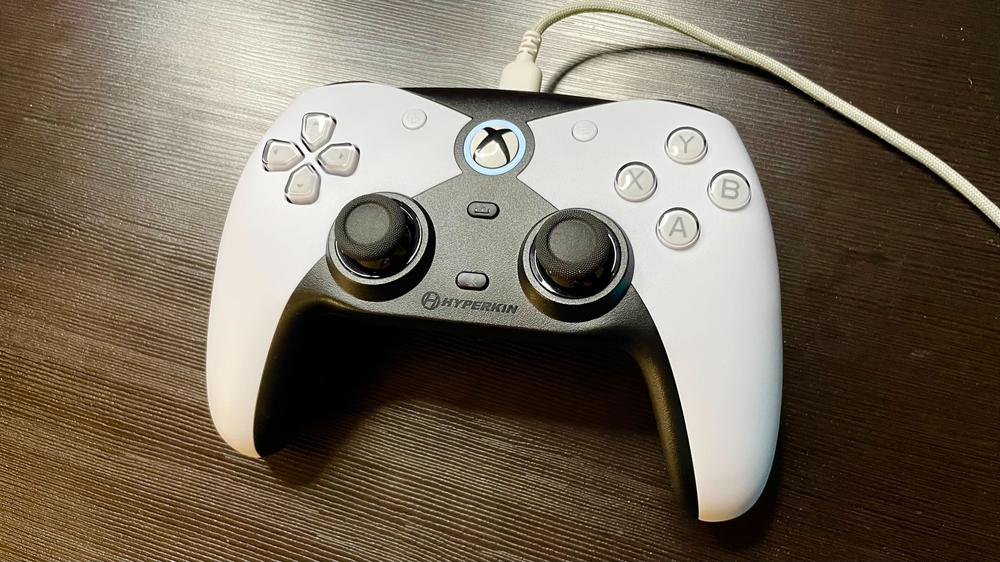Listen, I know what it looks like, and I know that Hyperkin knows what it looks like – the Competitor is straight up an imitation of the PlayStation 5's DualSense controller. But it's not an alternative for the PS5, and instead an Xbox and PC controller that brings the PlayStation's signature symmetrical stick layout along with a few worthwhile features on the side. Hall Effect sticks and triggers might be what draw you to it, yet the smaller things like simple and responsive back buttons and bouncy D-pad are what help it stand out. Once you get past its aesthetic gimmick, you'll find a controller that doesn't necessarily break new ground, but gets the job done well all the same.
Hyperkin Competitor – Design and Features
Looking past the two-tone DualSense color scheme (it is also available in all-black), the Hyperkin Competitor is a smartly designed controller. Starting with the analog sticks, the anti-friction rings and metal stems help them glide along the full range of motion and the default stick caps are nearly identical to the DualSense's in terms of texture and concave depth. However, the sticks themselves don't have the same weightiness as either consoles' gamepads, giving the Competitor a slightly toyish feel even if it performs well. The symmetrical sticks will be hit or miss depending on your preference, but as someone who's played on all consoles for decades at this point, I can go either way – both have their merits and take no time for me to adjust to.
The face buttons are oddly small, and while they are quite responsive and springy for rapid button mashing, their spacing is another one of those design decisions that isn't necessarily bad, but feels a bit awkward due to a tiny increase in travel distance for my thumb. The D-pad works as a unified rotational piece with inward facing arrows, just like the DualSense, but I will say that the Competitor has it beat with a bouncier feel. For rhythm games and fighting games, I like that it's not squishy, which would tire out my thumb faster, and compared to the eight-way D-pad on the Xbox controller, it's a demonstrable improvement.
Above all else, I really enjoy using the back paddles since they're simple and effective. They sit along the grips where your middle fingers rest and you can sense them by their small bump. It doesn't take much effort to press them so they're a natural extension of the overall layout, and they're easy to program with the mapping button behind the controller. Each one has a switch that locks them in place if you don't want to use them or if you have a firm grip and want to avoid accidentally hitting them.
Don't mistake it for trying to do what the DualSense does, though. The Competitor isn't meant to be a sophisticated piece of tech, so you're not getting detailed rumble feedback or adaptive triggers (it's an Xbox/PC gamepad after all). That said, the Hall Effect triggers are exceptionally smooth, and the magnetic resistance helps you consistently apply the amount of pressure you want – that's useful for racing games where the analog trigger input matters. The shoulder buttons also closely resemble the DualSense's, but they're clicky like the Xbox controller.
You'll find all the other staples of an Xbox gamepad such as the Menu, Share, and View buttons (which are smaller and barely protrude, making them harder to use) and the Home X button right at the center. There's also a 3.5mm analog input for headphones and a mic mute toggle (which is adopted from the DualSense). In the package, you get a long 10-foot USB cable to connect the controller and swappable thumbsticks in case you prefer a more pronounced concave dip on your sticks.
Hyperkin Competitor – Gaming and Performance
Solely comparing the Competitor to the DualSense isn't exactly conducive to determining if it's a worthy alternative to the regular Xbox controller or your go-to PC gamepad. So, I put it through its paces by playing a bunch of Call of Duty: Black Ops 6 multiplayer, Hades II, and Hollow Knight: Silksong – and when it comes to performance, the Competitor certainly holds its end of the bargain.
The most important part for playing a shooter on a controller lies in the smoothness of the analog sticks. Lining up precise shots or quickly flicking in heated situations all felt right with the Competitor in the handful of rounds of Deathmatch and Domination I played in Black Ops 6, and that's a credit to how it let me stay nimble with their light resistance. Listen, I mostly play Hardcore on Stakeout (low time-to-kill and a small map) so I need to move fast, but also need proper control to be able to land shots from across the map's hallways. Mapping jump and reload to the back buttons kept me agile as well since they're light to the touch and easy to hit in a moment's notice.
As good as the base Xbox controller is, playing Silksong with its D-pad is a pain. Sure, it's tactile, but it's overly clicky and sharp around the edges in a way that digs into my thumb after hours of playing. Since the Competitor mimics the DualSense D-pad, you get that softer touch without losing precision, and its slight bounce makes platforming and exact directional moves less of a chore as it can be with other controllers. When it comes to Hades II, I'm just testing for good button feel and rapid tapping, which worked as well as I could ask from a budget-level gamepad.

 Bonus Sport 2025: cos'è, a chi è rivolto e come si fa domanda
Bonus Sport 2025: cos'è, a chi è rivolto e come si fa domanda